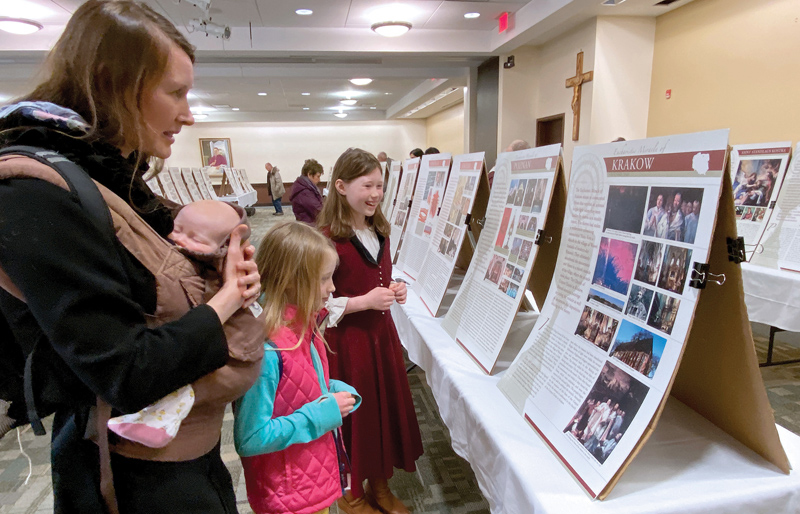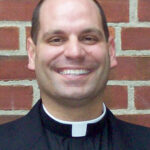Exhibit on eucharistic miracles feeding hunger people may not know they have

Kristen Kucner and daughters Lucia (asleep), Julia and Anna of Dunlap learn more about a eucharistic miracle from Poland, where the girls' grandfather is from. They visited the Vatican International Exhibition of "The Eucharistic Miracles of the World" on Nov. 19 at the Spalding Pastoral Center in Peoria. The Catholic Post/Jennifer Willems
When 9-year-old Anna Kucner learned the Vatican International Exhibition of “The Eucharistic Miracles of the World” was coming to the Spalding Pastoral Center in Peoria, she said to her mother, Kristen, “We’re going.”
“I read a book called ‘Eucharistic Miracles’ and I thought the whole thing was so cool,” she told The Catholic Post while viewing the exhibit on Nov. 19.
“She inspired all of us to learn more about them and strengthen our faith,” said Kristen Kucner, who was also accompanied by daughters Lucia and Julia and family friend Cecilia Steed. The Kucners are members of Sacred Heart in Peoria.
One of the big draws for Anna was that the exhibit of Vatican-approved miracles was put together by Blessed Carlo Acutis, who was just 15 when he died of leukemia in 2006. He was beatified on Oct. 10, 2020.
The exhibit has been to the LaSalle Catholic Community, Holy Trinity in Bloomington, Epiphany in Normal, and St. Vincent de Paul in Peoria. This time it was sponsored by the Eucharistic Disciples of Divine Mercy, which have a cenacle in Peoria.
“Part of our mission is to promote devotion to the real presence of Jesus in the Eucharist,” said Janice Lukich, the cenacle’s secretary.
The featured speaker for the day was Father Luke Spannagel, a priest of the Diocese of Peoria who is serving as one of 58 preachers for the National Eucharistic Revival. He talked about “Jesus in the Eucharist: How Miracles Can Support Our Faith.”
INTEREST IN MIRACLE GROWING
Interest in eucharistic miracles has continued to grow, Father Spannagel said.
“I think the hope is that as we are strengthened that we will be inviting others, that they will come and see what I saw. To see that Jesus is really there.” — Father Luke Spannagel
He said Jesus gives us the gift of eucharistic miracles now and then “to really capture our attention, to really strengthen us — inspiration to really bolster our faith.”
“We know that miracles are not required of our faith,” Father Spannagel continued. “We’re not required to believe in them, but they’re there for us if they’re helpful.”
He said there are three common patterns to the accepted miracles — those related to faith, those regarding reverence, and those in response to desecration of the consecrated hosts.
One of the oldest recorded miracles took place in Lanciano, Italy, in the 700s. A priest was filled with doubt as he celebrated Mass and wondered, “Jesus, are you really here or not?” At that moment the host was changed into flesh and blood.
Medical analysis of that miracle, which has been investigated many times, found that it was not only real human flesh, but heart muscle. There was the presence of Type AB blood, which is the rarest type but common to the miracles studied.
“All these miracles to me are amazing,” Father Spannagel said. “I think they’re always a call to deeper faith.”
The National Eucharistic Revival is an opportunity to renew our faith, he said.
“I think the hope is that as we are strengthened that we will be inviting others, that they will come and see what I saw. To see that Jesus is really there,” Father Spannagel said.
Barbara Harzman of St. Paul Parish in Macomb said she hopes he’s right.
“I think people are hungry, and they’re hungry for the Lord,” she said. “We don’t always know what we’re hungry for.”






